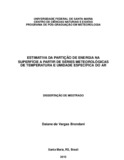| dc.creator | Brondani, Daiane de Vargas | |
| dc.date.accessioned | 2016-02-01 | |
| dc.date.available | 2016-02-01 | |
| dc.date.issued | 2015-07-03 | |
| dc.identifier.citation | BRONDANI, Daiane de Vargas. ESTIMATE OF THE SURFACE ENERGY PARTITION FROM AIR
TEMPERATURE AND SPECIFIC HUMIDITY METEOROLOGICAL TIME
SERIES. 2015. 57 f. Dissertação (Mestrado em Geociências) - Universidade Federal de Santa Maria, Santa Maria, 2015. | por |
| dc.identifier.uri | http://repositorio.ufsm.br/handle/1/10285 | |
| dc.description.abstract | The developed method is proposed with the aim of estimating the energy partition on the
surface, according to the Bowen ratio method, and the height of convective boundary layer
on the monthly scale. The basic hypothesis is that the average temporal evolution of the
variables air temperature and specific humidity is controlled solely by the convergence of
surface fluxes of sensible and latent heat. This assumption is valid for the monthly scale
and in mid-latitude regions away from the coast. Thus, it is assumed that the advective
terms of the balance equation of these quantities in the convective boundary layer in prefrontal
and post-frontal situations have opposite sign. Therefore, using for a longer time
scale than the typical scale of the passage of synoptic systems, the cancellation of terms
hypothesis can be tested. In this study, the method is applied to the region of Santa Maria,
where it is assumed that the conditions allowing despise the advective terms in a monthly
time scale are valid. Although the model is simplified, it was possible to estimate the surface
fluxes of latent and sensible heat from simple meteorological data, such as hourly
observations of air temperature and specific humidity and a vertical profile of these quantities
in the morning; the method was efficient in most of the cases, and more flawed in the
winter months. In general, the method overestimated consistently, but slightly, the latent
heat fluxes, while the sensible heat fluxes were slightly underestimated in the winter and
overestimated in the remaining months. This pattern caused a major deviation in energy
partition in the winter months. The method can also be used to provide time evolution of
the convective boundary layer. This is a variable of great interest for studies of pollutant
dispersion and in many cases it is difficult to estimate. | eng |
| dc.description.sponsorship | Fundação de Amparo a Pesquisa no Estado do Rio Grande do Sul | |
| dc.format | application/pdf | por |
| dc.language | por | por |
| dc.publisher | Universidade Federal de Santa Maria | por |
| dc.rights | Acesso Aberto | por |
| dc.subject | Fluxos superficiais | por |
| dc.subject | Altura da camada limite convectiva | por |
| dc.subject | Temperatura do ar | por |
| dc.subject | Umidade específica do ar | por |
| dc.subject | Surface fluxes | eng |
| dc.subject | Height of convective boundary layer | eng |
| dc.subject | Air temperature | eng |
| dc.subject | Specific humidity | eng |
| dc.title | Estimativa da partição de energia na superfície a partir de séries meteorológicas de temperatura e umidade específica do ar | por |
| dc.title.alternative | Estimate of the surface energy partition from air
temperature and specific humidity meteorological time series | eng |
| dc.type | Dissertação | por |
| dc.description.resumo | O método desenvolvido é proposto com as finalidades de estimar a partição de energia
na superfície pelo método da razão de Bowen e a altura da camada limite convectiva
na escala mensal. A hipótese básica é de que a evolução temporal média das variáveis
temperatura e umidade específica do ar é controlada unicamente pela convergência dos
fluxos superficiais de calor sensível e calor latente. Essa suposição é válida para escala
mensal e em regiões de latitudes médias afastadas da costa. Dessa forma, presume-se
que os termos advectivos, da equação de balanço dessas quantidades na camada limite
convectiva, nas situações pré-frontais e pós-frontais apresentam sinal oposto. Assim,
utilizando-se para uma escala temporal mais longa que a escala típica da passagem dos
sistemas sinóticos, a hipótese de cancelamento dos termos pode ser testada. No presente
trabalho, o método é aplicado para a região de Santa Maria, onde é assumido que
as condições que permitem desprezar os termos advectivos em escala mensal são válidas.
Ainda que o modelo apresentado esteja simplificado, foi possível estimar os fluxos
superficiais de calor latente e sensível a partir de dados meteorológicos simples, como
observações horárias de temperatura do ar e umidade específica e um perfil vertical dessas
quantidades no período da manhã; o método se mostrou eficiente em boa parte dos
casos, sendo mais falho nos meses de inverno. De modo geral, o método superestimou
consistentemente, mas de maneira leve, os fluxos de calor latente, enquanto os fluxos de
calor sensível foram levemente subestimados no inverno e superestimados nos demais
meses. Esse padrão causou um maior desvio na partição de energia nos meses de inverno.
O método também pode ser utilizado para fornecer a evolução da altura da camada
limite convectiva. Esta é uma variável de grande interesse para estudos de dispersão de
poluentes e, em muitos casos, de difícil estimativa. | por |
| dc.contributor.advisor1 | Acevedo, Otavio Costa | |
| dc.contributor.advisor1Lattes | http://lattes.cnpq.br/8696858608013659 | por |
| dc.contributor.referee1 | Timm, Andréa Ucker | |
| dc.contributor.referee1Lattes | http://lattes.cnpq.br/1307851743997556 | por |
| dc.contributor.referee2 | Tatsch, Jônatan Dupont | |
| dc.contributor.referee2Lattes | http://lattes.cnpq.br/2365902346826079 | por |
| dc.creator.Lattes | http://lattes.cnpq.br/0656979040032667 | por |
| dc.publisher.country | BR | por |
| dc.publisher.department | Meteorologia | por |
| dc.publisher.initials | UFSM | por |
| dc.publisher.program | Programa de Pós-Graduação em Meteorologia | por |
| dc.subject.cnpq | CNPQ::CIENCIAS EXATAS E DA TERRA::GEOCIENCIAS::METEOROLOGIA | por |


